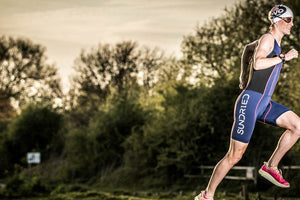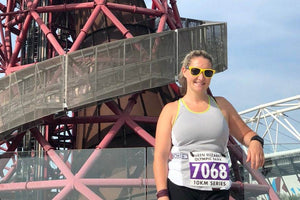
A 22-year career in the military has left me with many things and one that comes in handy with training is a head full of abbreviations and acronyms that would confuse most people. The particular acronym I want to focus on for this piece is the classic "5 Ps". “Prior Planning Prevents P*ss Poor Performance.” In the military, this would normally be delivered with a large slice of sarcasm when something has gone wrong but taken seriously does present a valuable lesson.
In my time coaching cyclists and multisport athletes one aspect of training I have noticed that works best for everyone is to have a sound plan in place aimed at a specific goal and the application of a structured schedule of progressive training. This sounds simple but seems to be overlooked quite easily and unfortunately, as the 5 Ps suggest, is an almost guaranteed recipe for disaster.
So how do you create a successful plan? The first step is to have a goal or target to aim for. Training can be very hard both physically and mentally and having a goal and end result target is the first step. This can be almost anything but must be a tangible real event or performance target. Choosing your event must be done with an element of realism from the off and, although all of the planning stages are equally important, getting this first step right will go a long way to promote success throughout the entire plan.
Choosing the right event for you should be based on a number of things but for me, it begins with a lifestyle survey. Plot a week in your life on a spread sheet and mark each day hour by hour including working hours, family commitments, sleep, travelling time etc and take a look at how much time you have left over for training. I always advise my athletes to involve their families at this stage too as getting agreement and a buy-in from your partner from the off is a big plus. Remember sport is part of life and not the other way around! So now you have an amount of time to train within and can start to estimate what you want to do with it. A good coach will help you maximise the training benefit from your allowable time but there is a limit to what you will be able to achieve hence the need to choose the event or target carefully.
Those that have heard of the SMART goals principle will see where the previous paragraphs are going so now is a good time to explain what SMART is.
- Specific. Training should be targeted at a specific goal or at a specific attribute of an event. What do I want to achieve? What are the requirements? What are the constraints? Every single training session should have an aim and all be part of the journey towards your goal or event.
- Measurable. How will I measure my progress? Will I know when the goal is achieved? What is deemed as success and can it be measured?
- Achievable. How can the goal be accomplished? What are the steps and progression path to success? This is sometimes replaced with Agreed. This would be a discussion with your coach to discuss the goals and objectives. The same questions would be asked and the coach offering some expectation management and guidance as and when required.
- Relevant. Is this a worthwhile goal? Is it the right time? Does this goal fit with my long-term objectives? Do I have the necessary resources to accomplish the goal?
- Time-bound. When is the event? How long will it take to accomplish the training targets? Use monthly or quarterly check points as smaller targets.
With all of the above taken into account, you now have a target set and know how much training time is available. The next phase is to start to construct a plan which leads you to the event or target and, within that, a weekly schedule which will cover all of the required aspects, as examined using the SMART principles.
The easiest way to do this is plan backwards from the event and applying a rotational schedule with recovery periods and rest. This can be a 6-week rotation with 5 weeks of training and 1 week of recovery or a more sensible starter schedule of 3 weeks of hard training with 1 week of recovery between each 3-week working block. Plan back until you get to the present day and you have the spine of a plan already. You can easily add detail to this such as including levels of training required at what stage of the plan, progressing from winter endurance to tempo training and then Lactate Threshold and V02 work as the plan progresses towards the event. I always do this on a downloaded A4 year planner in the first instance as it is far easier to plan visually and then upload it into a spread sheet or online software package when you have written it all out and are content.

My next piece of advice is to set small monthly targets and goals that will aid to maintain focus over a long training plan and also provide a good method of embedded progression monitoring. Training for an event that may be well over a year away takes real mental determination so setting progress check points and small goals that all add up to getting you to race day helps to break the overall target down into manageable chunks. This is almost a must! These can be distance based, power based, speed based or even to look for a reduction in perceived effort over a certain test session. These check points can and often will be pure performance tests to maintain the accuracy of training zones whilst still offering a repeatable review of improvement and progress.
The last major step of the planning phase is to populate your weekly schedule. This will need a return to your lifestyle survey and a look at where and when you have training time. The schedule will need to include sessions aimed at meeting the targets set whilst also allowing for adequate and proportional rest. The one big reason a lot of people fail in training effectively is an over estimation of time available. You must be honest with yourself right from the off.
I have included a very simple sample week below to demonstrate how you would possibly schedule and sessions for a Duathlon training plan.
|
Monday |
Tuesday |
Wednesday |
Thursday |
Friday |
Saturday |
Sunday |
|
Slow run 5km. Strength and Conditioning. Stretching and foam roller. |
Track running speed session. 5-6km total |
Brick session. Bike to run or Run to Bike. |
Bike Interval session. 1-1.5 hours. Strength and conditioning. Stretching and foam roller |
Rest Day. No training. Stretching and foam roller. |
Long run. Steady Paced with no efforts. 12-16km |
Long Road bike ride. Steady paced with no efforts. 2.5-3 hours |
In conclusion, a plan can make or break an event and must be the starting piece for any sporting ambition. How do I get to where I want to be and what am I going to do to get there? With intelligent use of the SMART principles and a process of constant review, you will be on the path to success.
About the author: Mark Griffin is a cycling and multi-sport coach based in Morton, Lincolnshire. He is the coach for Claire Steels duathlete, a Sundried ambassador.
"Coaching is a hobby for me and is fitted in around my normal day job as an Aviation Safety Consultant. I do still try to keep fit myself and am currently training for my 2 ultra-marathons in July this year. It’s a busy life but I love the coaching and seeing people enjoy sports as much as I do. My team is currently made up from a British and European AG Duathlon Champion, a double AG Duathlon World Champion now competing as Elite, as well as 2 further GB Age Group athletes and two specialist cycle Time Trial racers."








